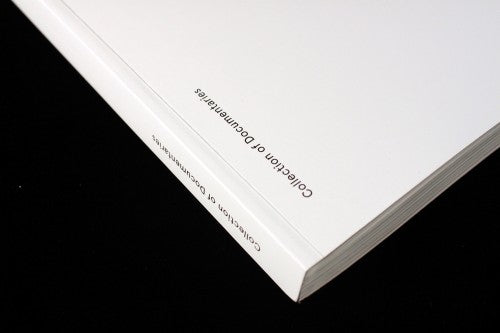
Magazine of the week: Collection of Documenteries #1

People often say that ‘a picture is worth a thousand words’, a dictum that rings true when exploring the content of the ambitious first issue of Collection of Documentaries (C.O.D). Contained in the thick, glossy pages of the chunky publication are an assortment of visual essays that explore the essence of British culture in modern-day society. For a magazine that looks to document contemporary life, C.O.D has a decisive and refreshing lack of an online presence (check out their website); existing simply as a physical entity and opting out of having content trickle and fragment into cyber space. Allusions to modern life are instead conveyed in the images themselves: one series explores the multiplicity of selves that exist on online profiles; another is interspersed with hurried, opportunistic photographs taken on mobile phones.

Adam J. Evans-Pringle’s page design is simple and clear: a white background frames each image, giving the photographs central importance. Pace and emphasis are conveyed through the placement or size of each picture: In ‘The Destruction or the Illusion of Demolition’ the sensation of fast movement is evoked by the corner positioning of a photograph of two boys swinging through a fence – as the boys swing, we swing to the next page as well (above). From the same series, a picture of hooded boys hugging fits the entirety of the page, a still and consuming effect that invites us to dwell on their camaraderie (below).

Following this visual essay depicting Britain as a war zone of smoke, skin-headed boys and destruction is a series entitled ‘Rehearsals’ depicting dancers in training (above). The transition from one series to the next creates an enticing juxtaposition: running bodies on the street become contorted bodies in the rehearsal room - Britain is evoked as a place of movement and dynamism.

The photographs are not just a love letter to the country; many of the images also champion the male body. A triad of photographs aligns the male torso with power as a young boy is contrasted with a statue boasting an authoritative fist pump (above), whilst a series entitled ‘escrt_ethan:::vers_19’ offers a softer view of male sexuality (below).


The tone of the images takes a turn towards the public school towards the end of the issue; moving away from ‘A Clockwork Orange’ and into the realm of ‘If….’ A pink tint and decorative headline face break garishly from the minimal aesthetic of the rest of the pages (above). This near-satirical shift from Adidas tees to Tommy Hilfiger suits and ties emphasises the ongoing, pervasive class-consciousness of the country.
The pictures both challenge and confirm the nostalgic clichés and associations of ‘Real Britain’, and as Lee Crichton notes in his editor’s letter, the contributors work together to celebrate the ‘old, new, unseen and overlooked’ aspects of Britain today. The magazine’s photographic assemblage is very much an interpretation of the country, it is in no ways all-encompassing – for a magazine that sets out to document British culture and youth, it could perhaps do with more of a glimpse into obscure female Britain as well.
As it is, C.O.D is a portrait with a particular focus on masculinity, power relations, youth culture, rebellion, and class war, a Britain we’ve seen in films like ‘This Is England’ and ‘Kes’. The project is an impressive feat: the sheer scale of the thing makes it more of a coffee table book than an ordinary publication, and to convey the message of your magazine through visual essays is a brave move, as is rejecting social-media.
Review by Madeleine Morley



